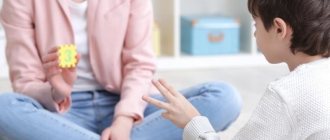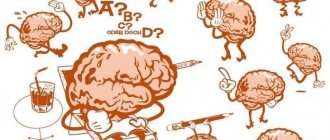At the present stage, preschool education plays a big role. Even more and more demands are placed on children of senior preschool age every year, especially in senior preschool age before directly entering school. Children must learn to comprehend educational information before they set foot in school.
Often, children of senior preschool age are prepared for school by instilling in them general and special knowledge, certain skills and certain skills. But they do not attach importance to the formation of their cognitive mental processes, and first of all, perception. But this is no less important. And maybe even the basis for successful schooling. After all, if a child of senior preschool age does not learn to perceive information, he will not be able to comprehend, process and evaluate it. The child will not master the school material and curriculum; his knowledge will not be formed.
Perception of the world in preschool age
Preschoolers are attracted to bright objects, melodic or original sounds, and emotional situations. They perceive the surrounding reality involuntarily, directing their attention to what attracts them most.
A child, seeing an object, is able to evaluate the functions known to him, intuitively analyze his experience and understand what he sees, hears or feels. A little baggage of life experience helps to understand what kind of sensation it is, to recognize an object, sound or smell.
The development of perception in preschool children allows them to move to the next step, when they learn to purposefully study objects, determine their characteristics, and differentially perceive individual properties.
What is a child's perception
Over the course of several preschool years, a child goes from directly perceiving an object through touch to the ability to isolate essential features and form a generalized idea of objects.
The function of cognition works as follows: perception arises as a reflection of a phenomenon or object using vision, hearing or touch.
Perception or perception is the process of receiving and transforming information using the senses, thanks to which a person develops a picture of the real world.
The perception mechanism can be briefly described as follows:
- The world around us consists of many signals: sounds, colors, pictures, tangible objects;
- By inhaling a smell or touching a piece of paper, the baby evaluates the object using one of the senses;
- This information enters the brain, where the sensation is born;
- Sensations add up to a complex picture, forming perception.
Perception is also influenced by previous experience. The senses help the child reduce information processing where he sees a familiar environment. Having received an idea of the toy bunny once, he will not need to touch or taste it again.
Perception is the basis for the further formation of cognitive functions necessary for full development and successful study.
Formation of sensation and perception processes
From birth, a child has what is called sensory perception. Smells, tactile sensations, and noise reach his brain, but the baby does not yet know how to use these signals. In the first years of life, children master object-related activities and accumulate information about the properties of objects, as a result of which sensory standards are formed.
From the age of three, perception gradually becomes accurate and meaningful. The higher visual and auditory analyzers are developing.
The child cannot yet comprehensively analyze an object or phenomenon, but he grasps the most noticeable signs, involuntarily comparing them with standards and drawing conclusions.
From a general understanding of objects at 3-4 years old, the youngest preschooler moves on to more complex forms of interpretation. With the active support of adults, the characteristics of sensations change, the child manages to realize that shape, color, material, size are more abstract characteristics and are not tied to a specific object.
By the senior preschool age, the child becomes familiar with the basic figures of geometry, identifies all the colors, and learns to determine the sizes of objects. He also understands that in the world there is a time, morning always turns into day, and then gives way to night. It is an achievement to realize the space from the house to the park, but the houses and trees stretch upward.
The importance of the development of perception in preschool age lies in the fact that with its limited functioning, the development of speech, memory, thinking, attention and imagination will be significantly hampered. This cognitive process becomes a necessary assistant for the manifestation of various types of thinking, the ability to speak figuratively and come up with vivid stories.
Properties of perception
Among the leading qualities of perception, the following parameters are reflected:
- Concreteness, that is, the ability to reflect various objects and processes of the real world in the form of separate objects.
- Solidity or completeness, that is, the reflection of objects in the complex of their properties.
- Structurality is a feature that is demonstrated in the fact that the personality assimilates, so to speak, a collective device that is formed over a certain time period, isolated from the emerging sensations.
- Stability, expressed in the constancy of specific parameters of objects in combination with varying conditions of their perception.
- Rationality, that is, the existence of a relationship with thought processes.
- Initiative (or selectivity), which consists in the perception of only one object or group of objects in a certain time period.
Types of perception in preschoolers based on perceptual systems
The main types of perception in preschoolers are based on various analyzers:
- Visual, allowing you to visually evaluate all the properties of an object;
- Hearing, which helps to learn speech, recognize the native language, feel the sounds of nature, hear music;
- Tactile, providing knowledge of an object through touch.
Auditory
With the help of hearing, the child learns to recognize the sounds of his native language, words and syllables. If in infancy the perception of speech is based on the rhythmic and melodic structure of words and sentences, then already at 1 year the formation of phonemic hearing begins. The baby needs another year for the acceptance of all the sounds of his native language to take shape and for the formation of a sound culture of speech to begin.
The development of auditory perception is most effective during walks, when the baby listens to the noise of the street, birdsong, the sound of rain, and steps. An excellent exercise is to close your eyes and try to understand from which side the bird is singing, or whether a car is driving far or close.
Visual
Visual perception is the leading one in preschool age. The ability to read, see the beauty of the world, and assess danger depends on it. Its leading role is justified by the fact that vision allows you to capture the entire object as a whole, as well as see details.
Visual signals arrive before the preschooler touches or tastes an object. In addition, examining an object is much safer than other methods of research.
Only at an early age, when the baby begins to comprehend the surrounding reality, his hands become his eyes. But at this stage, parents make sure that the child is in a protected space and that only safe objects are in his hands.
According to statistics, the number of visual people (who prefer visual perception) prevails in the world, so the development of this type requires special attention. The task of an adult in preschool age is to sharpen the child’s visual perception, and also to help him expand the range of perceived details.
With preschoolers you need to draw more, study pictures and illustrations. It is these children who enthusiastically engage in appliqué, putting together puzzles and mosaics, continuing to develop their visual senses.
Tactile
Tactile or kinesthetic perception is directly related to touch. Younger preschoolers still trust their hands even more when familiarizing themselves with a new subject. That’s why they so insistently ask to give them something that interests them. More details about tactile perception.
Playing with materials of different structures, modeling, natural substances is a great way to develop the sense of touch. With their eyes closed, children enjoy rolling the foil into balls and smoothing it out. Great joy comes from the exercise of identifying bulk material in a cup. The eyes, of course, must also be blindfolded.
Channels of information perception
The channels of perception mean the predominant direction towards one sense organ, which ensures better assimilation of incoming information. It is worth considering the factor that each person has his own individual orientation. For some, it is enough to read the material once to master it, for others it is necessary to listen to a lecturer on the same topic, etc.
Visual channel. Aimed at assimilation of information by focusing more on visual images. A person who is dominated by this channel of perception has a high ability to absorb information through reading. In this case, it is enough for the individual to read the material, and the information will be firmly “fixed” in the brain. There is no need to retell what you read or share with others. If the information itself is contradictory, raises additional questions, or provokes a dispute, then the individual may need to familiarize himself in detail with different opinions in order to form his own point of view.
Auditory channel. Aimed at assimilating information by concentrating primarily on auditory images. If this channel of perception predominates, a person has a high ability to remember through listening to the desired material. Students whose auditory channel dominates perfectly absorb the proposed information during a lecture and don’t have to study anything at home - everything is already easy in their head, so there are no unnecessary questions left! If difficult moments arise, the material is complex and incomprehensible, such a person usually strives to immediately clarify important details and figure it out on the spot by asking the lecturer the appropriate questions.
Kinesthetic channel. Aimed at assimilation of information by focusing primarily on physical sensations. Kinesthetic perception is closely related to the organs of touch, so such a person must touch the interlocutor during a conversation. Smell and taste are also of paramount importance for this person - she is most attentive to details and her own feelings. If you ask a person what is happening to him, he will be able to describe his emotions in colors and recognize their true manifestations.
Digital channel. Aimed at assimilation of information by concentrating on abstract-logical images. Such a person is inclined to look for meaning in everything, to sort his knowledge “on shelves”
It is extremely important for a digital person to know for what purpose he performs this or that action and what will follow from it. He has the ability to predict the situation, and therefore is prone to planning and in-depth analysis of current events
Most often, digital people are engaged in scientific activities throughout their lives.
The listed channels of perception are leading, but besides them there are others: gustatory, olfactory, semantic, etc. In accordance with the presented features of each channel, psychology distinguishes the following types of information perception: visual, auditory, tactile, verbal. Each of the listed types is fully correlated with the above-mentioned channels of information perception.
Peculiarities of perception in younger preschoolers
In early preschool age, perception is characterized by the following features:
- The inseparability of a property from an object. The big fluffy tiger at the zoo will be called a kitty.
- When studying objects, the most vivid, memorable detail stands out. That is why the wide witch's hat in the picture turns all the elegant old ladies on the street into evil witches.
- A sharp change in the usual surroundings around a familiar object prevents the baby from identifying it. Mom and dad in ballroom dresses become strangers.
Such specificity is typical for children of 3-4 years of age; in the future, perception will become more differentiated, individual functions will be highlighted, and the whole will be fragmented into particulars.
Perception of space by children 3-4 years old
The difficulty of understanding space lies in the inability to touch, smell and see it. The first step is to recognize the close space, that is, the surrounding world at arm's length with a toy.
Subsequently, the younger preschooler begins to understand the concepts of far and near, but they are not precise. The small statues on the bridge may appear to be dolls, and the child may well ask the mother to get one of them.
According to research, in order for a preschooler to begin to correctly perceive space, he must first evaluate his own body in this world. Learn to distinguish and name arms and legs, understand which parts of the body are paired. An additional way to master the concept of space is the constant work of an adult, aimed at indicating the direction. The more often the words are heard: right, left, side, in front, above, the easier it will be for the baby to master orientation in space.
The next stage of the task is to compare length, width and height. Over time, the baby begins to solve such tasks by eye, demonstrating an understanding of what space is and how people and objects are located in it.
Color perception
The difference in colors is available to the baby from an early age. Now we are not talking about the finest shades, but it highlights the main tones of the spectrum.
At 3-4 years old, a preschooler clearly distinguishes 4 primary colors:
- Red;
- Yellow;
- Blue;
- Green.
This aspect is associated with the age-related feature of seeing the main thing, discarding the unimportant, that is, incomprehensible and unknown shades. Data and reference shades are learned casually, without special training. But in order for the baby not to suffer from poor color perception, the names of the remaining tones and shades must be named and shown to him.
Children tend to replace color with the concepts of beautiful and ugly, which results in pictures where the shades of objects do not closely correspond to reality. In this age period, colors are discarded as an unimportant factor, and form becomes the basis.
Therefore, the development of color perception should consist of exercises where the simplest tasks of adding up an elementary color figure are replaced by more complex ones.
Peculiarities of perception in older preschoolers
Senior preschool age is marked by the presence of formed spatial representations. The child is well oriented in space, perceives distances and relationships between objects, and is able to visually model part of a specific room. He is also able to construct a model of the plot of a story or fairy tale.
The future schoolchild is already able to evaluate such an abstract concept as time, as well as see the world around him from an aesthetic point of view. It is these two areas that require the most attention.
Perception of time
The main features of perception in children of senior preschool age are the awareness of the combination of space and time. However, the inability to hear or touch these quantities leads to their prolonged recognition.
A child of 5-6 years old is able to remember time periods: yesterday, today, tomorrow, minute, hour, but there are no skills in using these concepts. The uniqueness of the perception of time is due to the fact that the child does not have the opportunity to manipulate it in a direction, and the terms are simply words that do not have a visual expression.
At this age, time indicators of the sequence of events yesterday, tomorrow, and the day after tomorrow are still poorly differentiated. The future tense is already realized, but the past causes difficulty. Preschoolers are happy to say who they will be when they grow up, what they will have, what they will do. They perceive the past discretely and emerge in the images of remembered events.
Adults will help the child perceive small periods of time if they correlate his activities with the time interval: draw a house with a garden in 10 minutes, sit at the table in 3 minutes, brush your teeth in 1 minute.
Aesthetic perception
But aesthetic perception blossoms magnificently. In older preschool age, every child is a creator. Children sculpt, draw, design, these activities help them understand the world better.
Much of the credit for this activity goes to visual perception. An older preschooler learns to examine objects holistically, tracing the outline and isolating details.
This information becomes a model that the child follows in his drawing and modeling.
If a five-year-old child’s judgment about aesthetics is determined by appearance, and objects are evaluated on the basis of like or dislike, then at the age of 6-7 a preschooler pays attention to artistic composition and color compatibility. For example, in a painting he is already able to capture characteristics that are not on the surface, which the artist put into the content.
The task of parents and educators is not just to inform the child about the beauty of this or that object. It is important to explain in clear words what exactly ensures the aesthetics of a phenomenon, the relationship between individual features and the overall result.
Regular activities of this nature help to cultivate a sense of beauty in a little person. He will learn to see beauty in the sound of drops on glass or falling leaves.
How does visual perception develop as a child ages?
The younger preschool age turns out to be the most important for the development of visual perception. The child’s character of research and orientation activity changes; he moves from the simplest manipulation of an object to a more detailed familiarization with it through touch and vision.
In 3-7 year old children, the most important distinctive feature of perception is that it becomes leading, combining the experience of numerous indicative actions. It already allows you to cover many details, to grasp their qualities and relationships. The process of viewing is formed, because at an earlier age children almost do not examine objects or manipulate them. However, the baby still cannot control his gaze, so he wanders randomly around the object. The perception of 3-4 year old children is controlled by the teacher in the process of various activities. The most important way to examine objects is a chain of perceptual actions.
By the age of 5-6 years, the perception of space changes significantly. Children increasingly want to understand the variety of forms they encounter and try to establish what a given object looks like. Adults should help them with this
Children can already compare the lengths of lines quite successfully, but when solving more complex problems using the eye, things are still not going well. It is better to improve the eye gauge when engaged in construction, when the child needs to select missing parts for construction or, during sculpting, divide a piece of clay so that there is enough of it for all elements of the object.
You can also exercise your eye through games, drawing, and applications. During the examination, the properties of the perceived object seem to be translated into the language of the system of sensory standards that the baby understands. By sensory standards we mean ideas about the properties of objects perceived sensually. These ideas are characterized by generality, since they reflect the most important, essential qualities. Standards do not exist separately, but form certain systems, such as a system of geometric shapes, a spectrum of colors, etc. The understanding of standards is expressed through their name, that is, a word, therefore the connection of perception with speech and thinking causes its intellectualization. At 6-7 years old, the child has almost formed all types of analyzers, and with their help, all types of sensitivity continue to develop. Visual sensations and perceptions are especially important at this age. It is known that a child receives up to 80% of all information about the world around him through vision. By the age of 6, there are much fewer errors when distinguishing colors. At 6-7 years old, in addition to the primary colors, a child knows a number of shades. For five-year-olds, perception is still involuntary. But by the age of seven, children can already set themselves the task of studying a subject and comparing it with others.
In child psychology, the question remains debatable about what the child relies on when perceiving an object: recognition of its individual parts or a holistic reflection
For a child’s productive perception of an object, the action that the child uses in the process of perception is very important. As a result of this process, he acquires personal experience, while simultaneously assimilating collective experience
Thus, with the development of perception, not only does its volume, accuracy, and meaningfulness change, but the method of perception itself undergoes restructuring and becomes more and more perfect.
Ways to develop the perception of preschoolers
In preschool age, the leading activity is play. It is in this form that children learn and develop the necessary functions in the best way.
Didactics presents many games for the development of perception that will help parents or educators engage with their child:
- Droplets teach how to combine objects based on color criteria. When completing the task, you need to put mugs of the corresponding shades in containers.
- Umbrellas form an understanding of the shape and color of objects. To play you need 4 umbrellas of primary colors and cardboard geometric shapes. The teacher reports that it is raining, it is urgent to hide the circles and triangles under umbrellas of different colors.
- A bag of secrets allows you to identify an object based on tactile sensations. An opaque bag is filled with toys. The child, without looking, must describe what came into his hand.
Similar games are played to develop the ability to recognize an object or item by smell or sound.
Regular classes to develop perception in preschoolers will ensure the further formation of a holistic, moral personality. Such a person will most likely have unconventional thinking and a high level of creativity.
Mechanism and types of perception
For the full development and effective learning of a child, a sufficient level of development of perception is necessary. It is the basis for the formation of other cognitive processes (memory, attention, thinking, speech and imagination). How does the process of perception occur?
- The world around us consists of various objects and phenomena that can be seen, heard, touched, tasted, smelled.
- With the help of our senses we learn about what an object is. For example, an orange has the following properties: round, orange, smooth, with small dimples on the peel, sour, and has a specific citrus smell.
- Information from the senses enters the brain, where individual sensations are combined into a holistic picture - perception.
- Perception is greatly influenced by accumulated life experience. If a child has already seen and eaten an orange, he does not need to taste it to guess what it is.
Classification of types of perception:
- Visual perception allows you to obtain a visual image of an object, as well as study its details;
- Auditory perception makes it possible to understand speech, recognize various sounds of nature, household noises and hear music;
- Tactile perception - cognition of objects using touch;
- Olfactory perception , recognition of odors;
- Taste perception - receiving information from taste buds (perception of sweet, salty, sour and bitter).
Most experts believe that each of us has a leading channel for receiving data about the world (usually vision, hearing or touch). Pay attention to the form in which your baby better assimilates information; it should be the main one in his learning.
Visual perception
Visual perception is one of the most important. According to research, vision supplies us with more than 80% of information, and 20% comes from the other senses.
Visual perception is based on a person’s ability to sense light flows, and light of different wavelengths, reflected from objects, causes different color sensations.
Humans may have less sensitivity to light than a cat and a shorter visual range than an eagle, but human perception has many unique and useful features.
Color vision
Color is nothing but light of different wavelengths, but it has a huge significance in our lives.
Color perception is so important for humans that the color around us can influence:
- our mood;
- performance;
- and even on physical condition.
In an environment poor in colors, a person experiences “color starvation,” and young children even experience mental retardation (read about the specifics of the influence of colors here).
Higher animals are also capable of distinguishing colors, but their abilities in this are not comparable to humans. Even an ordinary, untrained person can easily distinguish 150 shades. And colorists are able to see more than 10 thousand colors.
Meaningful vision
People don't just perceive light signals; our brains constantly process visual information. Visual perception is conscious. We think everyone has encountered a situation when, having seen an unfamiliar object, we painfully try to understand what it is, rummaging through our memory, trying to find something similar there or to evoke an association with a familiar object.
Unlike humans, animals react only to objects that are significant to them, and evaluate unfamiliar ones according to their degree of danger or edibility.
Types of visual perception
Visual perception is diverse, and within this perceptual process several types are distinguished.
- Shape perception, which relates to a person's ability to differentiate between a basic figure and a ground. They can change places, depending on the significance and focus of attention. For example, a book lying on a table littered with papers, pens, notepads and other objects can be perceived by us as the central object, and the rest will be the background. But if we need, say, a pen, then it will become the object. Although this only applies to space filled with approximately homogeneous objects.
- The perception of space is also a special type of visual perception. It includes the ability to see the depth, volume, distance of objects and their shape. It is interesting that a two-dimensional image of an object appears on the retina of the eye, and its three-dimensional image is formed in the visual part of the brain. This ability is believed to be related to binocular vision, and the 3D-effect image is created by superimposing two “pictures” from each eye, as in a stereoscope.
However, everything is much more complicated. After all, if a person loses the ability to see with one eye, then the picture still remains three-dimensional and three-dimensional, just like the perception of the depth of space. Our brain compensates for the missing information with that stored in memory and completes the image to the required “three-dimensionality.”
But visual perception has not yet been fully studied; there is a lot of incomprehensible and even mysterious things in it. For example, how do we see moving objects?
- Most researchers believe that information about the movement of objects comes to the brain from the nerve endings of the eye muscles when it moves behind the object.
- Other scientists believe that the perception of motion is associated with the movement of an image across the retina.
Peculiarities of perception in early preschool age (3-4 years)
The perception of 3-4 year old children is characterized by specificity and lack of clarity. The main parameters of perception in early preschool age are color, shape and size. Most often, children pay attention to the most striking of these signs, and the rest of the details are guessed by them. For example, seeing buttons with numbers on the TV remote control, children often decide that it is a telephone. It is interesting that three-year-olds do not recognize even the closest people if they are dressed in carnival costumes. At this age, children clearly distinguish primary colors (red, yellow, blue, green). Little-known shades are perceived as unimportant signs, and therefore are often simply ignored. However, kids learn quickly and remember everything on the fly. The more color standards you introduce your child to, the brighter the baby’s perception will be. Sometimes children evaluate the color characteristics of objects as beautiful or ugly, so in drawing you can see the child’s color preferences, and not real images of objects.
The properties of objects for younger preschoolers are inseparable from the things themselves, so they are firmly fixed in perception. For example, a baby knows that a cucumber is always green, and can call zucchini, avocado, and green beans cucumbers.
In children of this age, their perception of space is formed through actions with objects. A 3-year-old child is just beginning to distinguish between the concepts of far and near, so he has difficulty estimating the size of distant objects. For example, looking at the panorama of the city, a child may well think that the houses are toy. To develop the baby’s spatial representations, you need to pay his attention to his own body (the child will quickly remember that the legs are below, the head is above, the arms are at the side), and also more often give the child requests indicating the direction (for example, turn right, take candy from the top shelf and so on).
How do children of middle preschool age (4-5 years old) perceive the world?
By the age of 5, children achieve significant success in their ability to perceive various parameters of the world around them:
- There are 7 or more colors;
- Have an idea of light and dark tones, warm and cold shades;
- Know the basic geometric shapes (circle, square, triangle, rectangle);
- Can compare objects by size (large, smaller, small);
- They begin to form the concept of time (today, yesterday, tomorrow, minutes, hours, days, weeks), but they are not yet able to apply knowledge about these abstract concepts into the life of a four-year-old;
- The perception of other people depends on their popularity in society and their relationship with the baby. Mom will always be perceived by the baby as the kindest and most beautiful.
Peculiarities of perception in older preschool age (5-7 years)
In older preschool age, as before, visual sensations dominate perception. Auditory perception begins to actively develop: children are able to identify sounds in words, recognize familiar musical compositions, and feel the tempo and rhythm of a piece. Six-year-old children are well oriented in space (they practically do not confuse right and left, perceive distances between objects quite accurately, and can navigate plans and diagrams). The perception of time periods (minute, hour, day, and so on) depends on how often parents mention them in communication with their children. If you give your child tasks in which time is one of the guidelines (for example, draw as many circles as possible in a minute or you need to brush your teeth for 2 minutes), gradually it will no longer be so incomprehensible to the child.
The leading channel of perception for most older preschoolers is vision. At the same time, other types of sensitivity (especially auditory and tactile) are also actively developing.
Games and exercises for developing perception in preschoolers
The game is a leading activity in preschool age. This is why exercises and games are an effective and fun way to develop children's perception.
- Sorting by color, shape, size. Items for sorting can be any available materials: toys, lids, construction parts, cubes, buttons, cereals, pencils, etc. You can organize the game in various ways: placing objects in bowls, hiding an object (arranging objects so that they blend into the background), throwing objects into holes of the desired color/shape/size.
- What is missing. This exercise develops visual perception, thinking and attention to detail. Draw several objects or animals on a piece of paper, but do not finish drawing them. One or more essential features of the objects must be missing (for example, a hare without ears, a table without legs, a car without wheels), and the baby’s task is to say what is missing in the picture.
- Confusion. Show your child a picture with the contours of familiar objects superimposed on each other. The child must name everyone who is depicted on it.
Regular exercises will help your child develop a high level of various types of perception.
- Puzzles and cut-out pictures. These games, in which the child needs to assemble a whole picture from pieces, are excellent for developing visual perception.
- Guess by the smell. From available ingredients you can create a whole aroma set (for example, garlic, coffee, cinnamon, berries, cucumber, lemon, chocolate, and so on). Ask your baby to close his eyes and guess the object by smell. You can also invite your child to draw what he associates this or that scent with.
- Whose sound? An adult hides behind a screen and uses objects to make various sounds: rustling a bag, tearing paper, knocking with spoons, ringing a bell, pouring water, and so on. The baby must guess which object each sound corresponds to.
- Magic bag. For this game you will need an opaque bag and small objects of various shapes and textures. Based on his tactile sensations, the baby should pull out the thing that you describe to him.
Period from 2 to 3 years: formation of lasting connections
By this age, the child has accumulated certain experience, it is already easier for him to recognize and distinguish between the objects that surround him. The connection between word and object is established much faster. From the age of two, children need only 4 repetitions to select an object by name. And the older the child gets, the more stable connections are formed between words and the differentiation of objects. Thus, as a result of observations, it was found that by preschool age, children, perceiving unfamiliar objects, are independently able to find their names by similarity to a symbolic object, for example, an oval - lemon, egg.
By the end of two years of age, a child is able to correctly name an object familiar to him, however, when identifying certain features, he may ignore individual details and make mistakes, for example, calling a tiger cub a cat and, generalizing objects based on various random features, calling them one word.
https://youtube.com/watch?v=U-6bDDM4RF0
conclusions
At preschool age, children experience a colossal leap in mental development, because during this period all cognitive processes are actively formed. Perception is the basic mental process on the basis of which all others (attention, thinking, speech, memory and imagination) are formed. Over the course of several years, children go from direct sensory perception to the ability to form a generalized idea of objects. If initially a child learns to recognize and evaluate what is in front of him at the moment, based on his own sensations and experience, then in older preschool age the level of development of perception allows him to purposefully study objects or phenomena, highlighting their properties. It is necessary to pay enough attention to the development of perception in children, because the child’s ability to learn largely depends on its level.
What is perception: definition of the concept
Perception is a cognitive process that forms in our minds a certain picture of the world around us.
Moreover, this picture is not objective, but is subjective in nature, that is, colored by personal impressions.
This process is also called perception, it begins with the action of our senses: vision, hearing, touch, etc., when we receive primary information about some object or phenomenon.
At this stage of perception, which is called the lower level, the cognition of the world by the simplest stops.
But vertebrates, for example, are capable of not only receiving certain information, but also analyzing it, evaluating it from the point of view of perceived danger, usefulness, or motivation for some activity or movement.
In humans this process is most fully expressed. Comprehension of information received from the senses has many stages and types.
Such a truly intelligent perception of the surrounding world is its highest level, it is called apperception.
The type of thinking based on the direct perception of objects is called visual-effective.
The process of development of perception in preschoolers
The development of perception at an early age allows you to understand the world around you, perceive and be aware of objects and phenomena.
In infancy, children cannot clearly and meaningfully perceive the surrounding space. The mechanism of perception through vision and hearing is underdeveloped. Gradually, from the first months of life, the child begins to evaluate the properties of surrounding objects: size, temperature, weight and shape. The child picks up music and rhythmic sounds, learns to navigate space and grasp the sequence of actions.
The process of perception in preschoolers develops when they play, draw, and use sensory sensitivity.
From the age of 4-5, children begin to navigate the color spectrum and identify geometric shapes. Gradually the process of perception improves, becomes systematic, logical and clear. A child can distinguish not only primary colors, but also saturation, shades, contrast and color combinations.
The development of perception in preschoolers gradually leads to the assimilation of a system of measures, quantities and the sequence of various objects. Children begin to develop a clear idea of large, medium and small objects, of measurements (length, height and width).
The process of development of perception in preschoolers improves with awareness of space and orientation in it. The most difficult process is the perception of time and time frames. Visual forms and actions help the child remember time conventions.
The development of perception in younger schoolchildren is based on artistic creativity and perception of literary works. In this process, a special role is given to cognition and experiences. The child learns to understand the meaning of the works and understand the feelings of the main characters.
The development of perception at an early age is effective through fairy tales, which are a form of psychotherapy and contribute to the development of the child’s personality.
Perception in preschoolers is actively manifested in value judgments. Adults should help give an assessment, highlighting appearance, defining their attitude, explaining moral qualities and actions. The child, giving an assessment and expressing judgments, shows likes and dislikes, highlights positive and negative qualities.
In the preschool period, value judgments are still unstable and changeable, but perception in primary school age becomes complete and developed. The child begins to perceive not only external, but also internal qualities.










